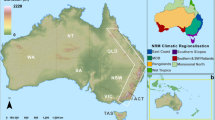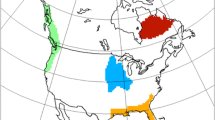Abstract
The study examines how regional climate models (RCMs) reproduce the diurnal temperature range (DTR) in their control simulations over Central Europe. We evaluate 30-year runs driven by perfect boundary conditions (the ERA40 reanalysis, 1961–1990) and a global climate model (ECHAM5) of an ensemble of RCMs with 25-km resolution from the ENSEMBLES project. The RCMs’ performance is compared against the dataset gridded from a high-density stations network. We find that all RCMs underestimate DTR in all seasons, notwithstanding whether driven by ERA40 or ECHAM5. Underestimation is largest in summer and smallest in winter in most RCMs. The relationship of the models’ errors to indices of atmospheric circulation and cloud cover is discussed to reveal possible causes of the biases. In all seasons and all simulations driven by ERA40 and ECHAM5, underestimation of DTR is larger under anticyclonic circulation and becomes smaller or negligible for cyclonic circulation. In summer and transition seasons, underestimation tends to be largest for the southeast to south flow associated with warm advection, while in winter it does not depend on flow direction. We show that the biases in DTR, which seem common to all examined RCMs, are also related to cloud cover simulation. However, there is no general tendency to overestimate total cloud amount under anticyclonic conditions in the RCMs, which suggests the large negative bias in DTR for anticyclonic circulation cannot be explained by a bias in cloudiness. Errors in simulating heat and moisture fluxes between land surface and atmosphere probably contribute to the biases in DTR as well.








Similar content being viewed by others
References
Blenkinsop S, Jones PD, Dorling SR, Osborn TJ (2009) Observed and modelled influence of atmospheric circulation on central England temperature extremes. Int J Climatol 29:1642–1660
Boberg F, Berg P, Thejll P, Gutowski WJ, Christensen JH (2009) Improved confidence in climate change projections of precipitation further evaluated using daily statistics from ENSEMBLES models. Clim Dyn 35:1509–1520
Brockhaus P, Luthi D, Schar C (2008) Aspects of the diurnal cycle in a regional climate model. Met Zeit 17:433–443
Christensen JH, Christensen OB, Lopez P, van Meijgaard E, Botzet M (1996) The HIRHAM4 regional atmospheric climate model. Scientific Report 96-4, Danish Meteorological Institute, Copenhagen, Denmark
Dai A, Trenberth KE, Karl TR (1999) Effects of clouds, soil moisture, precipitation, and water vapor on diurnal temperature range. J Clim 12:2451–2473
Dietmuller S, Ponater M, Sausen R, Hoinka KP, Pechtl S (2008) Contrails, natural clouds, and diurnal temperature range. J Clim 21:5061–5075
Giorgi F, Bi X, Pal J (2004) Means, trends and interannual variability in a regional climate change experiment over Europe. Part I: present day climate (1961–1990). Clim Dyn 22:736–756
Haylock MR, Hofstra N, Klein Tank AMG, Klok EJ, Jones PD, New M (2008) A European daily high-resolution gridded dataset of surface temperature and precipitation. J Geophys Res 113:D20119. doi:10.1029/2008JD10201
Jackson LS, Forster PM (2010) An empirical study of geographic and seasonal variations in diurnal temperature range. J Clim 23:3205–3221
Jacob D (2001) A note to the simulation of the annual and inter-annual variability of the water budget over the Baltic Sea drainage basin. Meteorol Atmos Phys 77:61–73
Jenkinson AF, Collison FP (1977) An initial climatology of gales over the North Sea. Synoptic Climatology Branch Memorandum No. 62. Meteorological Office, Bracknell
Kjellström E, Barring L, Gollvik S, Hansson U, Jones C and co-authors (2005) A 140-year simulation of European climate with the new version of the Rossby Centre regional atmospheric climate model (RCA3). SMHI reports meteorology and climatology volume 108, SMHI, SE-60176, Norrkoping, Sweden, p 54
Kukla G, Gavin J, Schlesinger M, Karl T (1995) Comparison of observed seasonal temperature maxima, minima and diurnal range in North America with simulations from three global climate models. Atmos Res 37:267–275
Kyselý J, Plavcová E (2010) A critical remark on the applicability of E-OBS European gridded temperature data set for validating control climate simulations. J Geophys Res 115:D23118. doi:10.1029/2010JD014123
Lenderink G, van der Hurk B, van Meijgaard E, van Ulden A, Cuijpers H (2003) Simulation of present day climate in RACMO2: first results and model developments. KNMI, technical report 252, p 24
Lobell DB, Bonfills C, Duffy PB (2007) Climate change uncertainty for daily minimum and maximum temperatures: A model inter-comparison. Geophys Res Lett 34:L05715
Niehörster F, Fast I, Huebener H, Cubasch U (2008) The stream one ENSEMBLES projections of future climate change. ENSEMBLES Technical Report No. 3, available at http://ensembles-eu.metoffice.com/tech_reports/ETR_3_vn0.pdf
Pfeiffer A, Zangl G (2010) Validation of climate-mode MM5-simulations for the European Alpine region. Theor Appl Climatol 101:93–108
Plavcová E, Kyselý J (2011) Evaluation of daily temperatures in Central Europe and their links to large-scale circulation in an ensemble of regional climate models. Tellus 63A:763–781. doi:10.1111/j.1600-0870.2011.00514.x
Roeckner E, Brokopf R, Esch M, Giorgetta M, Hagemann S et al (2006) Sensitivity of simulated climate to horizontal and vertical resolution in the ECHAM5 atmosphere model. J Clim 19:3771–3791
Samuelsson P, Jones CG, Willen U, Ullerstig A, Gollvik S, Hansson U, Jansson C, Kjellstrom E, Nikulin G, Wyser K (2011) The Rossby Centre Regional Climate model RCA3: mode description and performance. Tellus 63A:4–23
Steeneveld GJ, Mauritsen T, de Bruijn EIF, de Arellano JVG, Svensson G, Holtslag AAM (2008) Evaluation of limited-area models for the representation of the diurnal cycle and contrasting nights in CASES-99. J Appl Meteorol Climatol 47:869–887
Štěpánek P, Zahradníček P, Skalák P (2009) Data quality control and homogenization of air temperature and precipitation series in the area of the Czech Republic in the period 1961–2007. Adv Sci Res 3:23–26
Štěpánek P, Zahradníček P, Huth R (2011) Interpolation techniques used for data quality control and calculation of technical series: an example of Central European daily time series. Idöjárás 115:87–98
Uppala SM, Kallberg PW, Simmons AJ, Andrae U et al (2005) The ERA-40 re-analysis. Q J R Meteorol Soc 131:2961–3012
van der Linden P, Mitchell JFB (eds) (2009) ENSEMBLES: climate change and its impacts: summary of research and results from the ENSEMBLES project. Met Office Hadley Centre, Exeter, p 160
Watterson IG (1997) The diurnal cycle of surface air temperature in simulated present and doubled CO2 climates. Clim Dyn 13:533–545
Wild M (2009) How well do IPCC-AR4/CMIP3 climate models simulate global dimming/brightening and 20th century daytime and nightime warming? J Geophys Res 114:D00D11
Zhou LM, Dickinson RE, Dai AG, Dirmeyer P (2010) Detection and attribution of anthropogenic forcing to diurnal temperature range changes from 1950 to 1999: comparing multi-model simulations with observations. Clim Dyn 35:1289–1307
Acknowledgments
The authors are grateful to P.Štěpánek, Czech Hydrometeorological Institute, Brno, for providing gridded observed data. The RCM and GCM data were obtained from the ENSEMBLES project database funded within the EU-FP6, contract number 505539. The study was supported under project P209/10/2265 funded by the Czech Science Foundation. Thanks are due to anonymous reviewers for useful comments and suggestions.
Author information
Authors and Affiliations
Corresponding author
Appendix
Appendix
The airflow indices are calculated using MSLP in grid points shown in Fig. 1.
The westerly (zonal) component of the geostrophic surface wind is calculated as the pressure gradient between 45°N and 55°N and represents the westerly flow w:
The southerly (meridional) component of the geostrophic surface wind represented by the pressure gradient between 10°E and 20°E is the southerly flow s:
The resultant total flow strength is
The direction of flow DIR is calculated as
The total shear vorticity VORT is the sum of the westerly and southerly vorticity:
where zw corresponds to the difference of the westerly flow between 40°N and 50°N and of that between 50°N and 60°N
and zs is the difference of the southerly flow between 30°E and 20°E and of that between 10°E and 0°E
Constants used in these equations reflect differing sizes of grid cells at each latitude. DIR is expressed in degrees, while STR and VORT have units of hPa per 10° latitude at 50°N.
Rights and permissions
About this article
Cite this article
Kyselý, J., Plavcová, E. Biases in the diurnal temperature range in Central Europe in an ensemble of regional climate models and their possible causes. Clim Dyn 39, 1275–1286 (2012). https://doi.org/10.1007/s00382-011-1200-4
Received:
Accepted:
Published:
Issue Date:
DOI: https://doi.org/10.1007/s00382-011-1200-4




